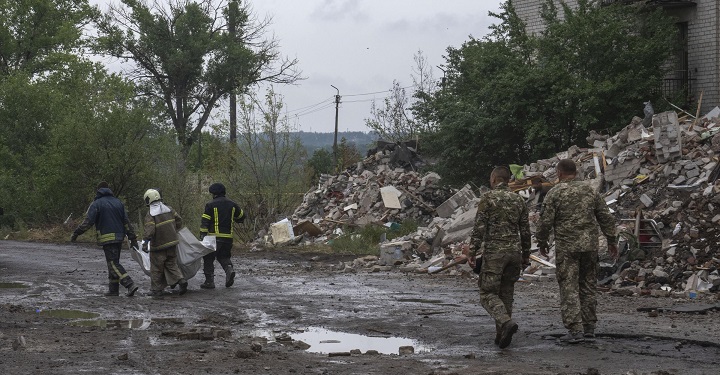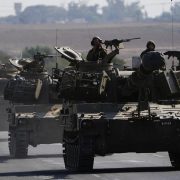
There are two optics of the invasion. There is the Russian vision and the Ukrainian one. Both think they are winning and thus don’t want to give in. But there are also two wars, one on the battlefield and one on the European home front. They are yielding contrasting results. The various paths of visions and wars are about to come to a crossing. It will decide what’ll happen next.
It may be a tale of two wars going in parallel. So far, they do not meet but will eventually do and prove one side or the other right.
The first version of the war is the Russian one.
Moscow lost politically because it thought the invasion of Ukraine would be a stroll in the park. It would have put the Kyiv government under Moscow’s control, split the European Union, and politically distanced the United States from Europe. None of these goals has been realized. The advance into Ukraine was a massacre and therefore failed. The attempt to encircle Ukrainian forces in the country’s east also failed.
Today the Russians have reverted to World War I tactics. They bombard, razing a target to the ground. When the target has been crushed, they move forward with tanks and infantry and then bombard a second target, thus in progression. These are slow tactics that are highly destructive of vehicles, equipment, and men.
The level of depletion of Russian assets is not precise, but the Russians have decided it doesn’t matter because they are moving into eastern Ukraine step by step. By moving there and conducting cunning political guerrilla warfare with gas and grain supplies, they are playing on the main objective: splitting the political unity of Europe.
Germany, which depends on Russia for 60% of its gas, is in a severe crisis. Its leading gas import company, Uniper, is effectively busted. Berlin is considering nationalizing the German operations of the Russian gas giants and bailing out the entire gas sector for the winter. It remains undecided on the issue of price caps for gas.
Italy is in a similar situation, with variations. Dependence on Russian gas has practically halved, but the political guerrilla waged now by Giuseppe Conte’s Five Stars Movement (part of the government and yet daily protesting government initiatives) has instead increased.
They threaten a government crisis. The fall of the Italian government in the middle of the war would be a big victory for Russian President Vladimir Putin and would put Russia back on track with its initial plans.
Moscow wouldn’t achieve everything, but at least some goals would be. Italy’s scalp, worn in tribute by Conte, would adorn Putin’s belt. That is why Moscow needs to move step by step and continue the gas guerrilla day after day, trying not so much to conquer Ukraine but to shake up Italy and Germany.
The Italian and German tensions, the concessions on payments in rubles, and the piquant reactions to Italy and Germany from Poland or the Baltic countries tell Moscow precisely that it is winning the war.
The Ukraine War
Ukraine sees things differently. It notes that the vehicles used by the Russians are getting older. From the T90 tanks of the early days of the invasion, they have moved on to their grandfathers, the T62s, a sign that the warehouses are emptying. Naval guns and missiles are being used on land positions, a sign that there are no more assets. They field Ossetians, Chechens, and Buriatians, but not Russians, a sign that the Russians are on a “war strike.”
On the home front, the number two of the Russian Orthodox Church, Ilarion, has been deposed because of his opposition to the invasion. There are spotty protests and strikes. Of course, the Russians are not easy to push back, but the Ukrainians think they are training artillerymen and tank drivers. New artillery systems can pulverize the Russian guns now dominating the field, with a 5-to-1 superiority. HIMARs are complicated anti-artillery systems that need trainers but can hit the Russians from greater distances with more firepower. They could be a game-changer in the conflict on the ground. America has thousands available already today.
The Ukrainians’ idea is that by September or October, these gunners will be ready, and with the new HIMARs artillery systems, they will be able to destroy the Russian guns and thus break through the front.
That is why the Ukrainians think they have time on their side, that this is not a war of attrition but a war of exhaustion of the Russians, who will arrive at the autumn rendezvous already shattered.
The two combatants have thus two optics on the war. Then, neither side wants to give in; both still think they are winning and that a clear victory is possible.
The Russians know that new American missile systems would be a game-changer, but the systems will not be available in a meaningful manner before September. It creates a situation whereby the Russians could continue pushing their gas guerrilla and tactical plans for the next two months.
By the time the HIMARs are deployed, they may seek a peace that is also backed by European rifts.
The War Back Home
In this situation, it is not the war on the ground in Ukraine that is important, but the war “home” in Germany and Italy in these two months.
The situation in Germany is highly complicated. It is not just about the support for a problematic war; it is that the politics on which the country had stood for the last 33 years are collapsing. The political relationship with Russia and the growing and strategic dependence on its gas allowed a series of political and industrial choices that have sustained the country until now.
Cheap Russian gas could help finance the green transition, a strategic issue for Germany. Moreover, the certainty and security of Russian gas also financed German industry with its exports.
Today not only is Russian gas being lost but the Russian and Eastern European markets are also being lost, both of which are irritated for different reasons by German attitudes. Gone is the idea that trade could be a substitute for politics and defense.
Thus, ghosts of a military Germany that Germans had wanted to bury are rekindled. For decades Berlin dreamed that the country could become a kind of Greater Switzerland, disinterested in world defense policy. At the same time, inflation, which brought enormous social upheaval a century ago, is rising again.
Diverting radically from this position is difficult because it is not easy to see the end goal. What should Germany do in the future? How should it deal with its intentions to promote green energy and to create a Greater Europe centered on Germany? What will become of its ability to export, which has been the country’s great driver until now?
On the other hand, Germany cannot even try to sweep under the rug the fundamental challenge posed by Russia. Germany has been the country that has gained the most since the end of the Cold War. It reunified and expanded its area of influence to the east, warding off the Russian threat with two layers of protection: first former Soviet countries that later joined NATO, and second, neutral countries, such as Belarus and Ukraine, that were supposed to buffer any Russian pressure.
The shift between these two countries—Belarus incorporated into the Russian empire, and Ukraine invaded—wrecks the German political dynamic. Germany, in short, has vast problems to solve that go beyond gas but find the spark to kindle everything in the gas issue.
These are systemic issues that Germans like to address systematically, and so without systemic answers, they are left collectively disoriented.
Here the Greens appear as the force that sees Germany’s change of pace most clearly and decisively. But for now, they are not strong enough to steer the rest of the country.
As long as the German powder keg is open, the Russians will try to keep fighting in Ukraine.
In this complicated alchemy, Italy’s role could be critical. If it takes sides among the “doubters” of the war, it gives weight to German doubters and thus galvanizes the Russians.
If, on the other hand, it takes a firmer attitude, then the Germans might also turn more easily.
In this situation, therefore, Conte is important. Whether he realizes the game he is playing, he is objectively Putin’s ideal ally.
Unlike Germany, Italy has no system or strategy. It is easier to steer, one way or another. It lives by improvising. Now it works this way with premier Mario Draghi; without him, anything could go wrong—or right, according to the optics. Then while nudging Germany one way or another is tough, twisting Italy on Ukraine could be a child-game.
The other element Europe misses is America’s political direction and heartful interest in the fight.
The US went to war on terrorism after 9/11, thinking it was a vital threat, but it doesn’t feel at war now. Still, the war in Ukraine is not about Ukraine.
It is a strategic hazard posed by Russia, 1, the other nuclear superpower, 2, over Europe, the global economic powerhouse, and 3, followed closely by China, the US main adversary. The three elements far outweigh any long-term risk posed in 2001 by the feisty Bin Ladens dug in an Afghani cave.






The writer has little notion of the way this war is fought. The purpose of Russia is to destroy the Ukrainian armed forces. While those are larger than the Russian forces engaged, a million against about two hundred thousand, the ratio of casualties is very much in Russia’s favor. At the same time Russia is concerned to minimize casualties among civilians.
In the coup of 2014 the US replaced the far from perfect democracy in Ukraine by a fully fake one. It then tried to build the Ukrainan armed forces to a size that could exhaust Russia in a war. But of course US is unable to train a foreign army. That was made abundently clear by the US trained Iraqi army being demolished by an IS army a tenth of its size in 2014.
The character of the current regime is Kiev is well illustrated by the case of MH17. In June 2014 the rebels took a Buk missile launcher from a Ukrainian army base. In August 2015 we were told that this launcher had been unable to launch any missile but this must have been known to Army HQ even before it was taken. On July 14 an An-26 of the Ukrainian air force was shot down near Luhansk and Kiev said it had been flying at an altitude of 6 km at the time. Then it should have been hit by the shrapnel caused by the explosion of a passing missile war head or shell. Everyone now knows about the shrapnel holes in the wreck of MH17. Not one such a hole was visible on the wreck of that An-26, a much smaller aircraft than a Boeing 777, on a photo published on internet a few hours later. It was clear Kiev had lied.
Three days later a Buk missile launched by the Ukrainian army shot down MH17 and Kiev immediately accused the rebels. The Dutch government formed the Joint Investigation Team two days later with as members itself, Belgium, Australia and Malaysia, explicitly excluding Russia and Ukraine because these had Buk missile launchers nearby. Three days later Ukraine was included because according to my Dutch newspaper NRC at the time that would assist in collecting and translating evidence in the Russian and Ukrainian languages and then this evidence didn’t need to be checked by the original members of JIT. But of course if either the rebels or Russia were guilty of downing the aircraft these checks wouldn’t have been a problem. It was only necessary to avoid these checks because MH17 was shot down by Ukraine. Was it then vice-president Biden who persuaded the Dutch government to include Ukraine in JIT?
The MH17 court case in the Netherlands has ended and we are awaiting the verdict. One item of evidence mentioned in my Dutch newspaper was an “intercepted” telephone convrsation in which a rebel leader demanded a Buk launcher for the next day because “otherwise there would occur a disaster”. If MH17 was the target what would have been the disaster if it had not been hit? Or if it was not the target where is the disaster caused by not hitting that other aircraft? Will the court dare to convict the accused and make my country a laughing stock?
Current western propaganda bases its expectation of a Ukrainian victory on a trust in western “Wunderwaffen” similar to such an expectation on the side of the Hitler regime when WWII in Europe neared its end. Instead the small part of the Ukrainian armed forces that is well trained is now being exterminated without at the same time destroying more than a small part of Ukraine.
The Russian economy is helped by considerable price increases of several important export goods including oil, natural gas, wheat and fertilizer. Also the influence of large western companies that resulted from the economic chaos of the ‘nineties is now being reduced.
I love it